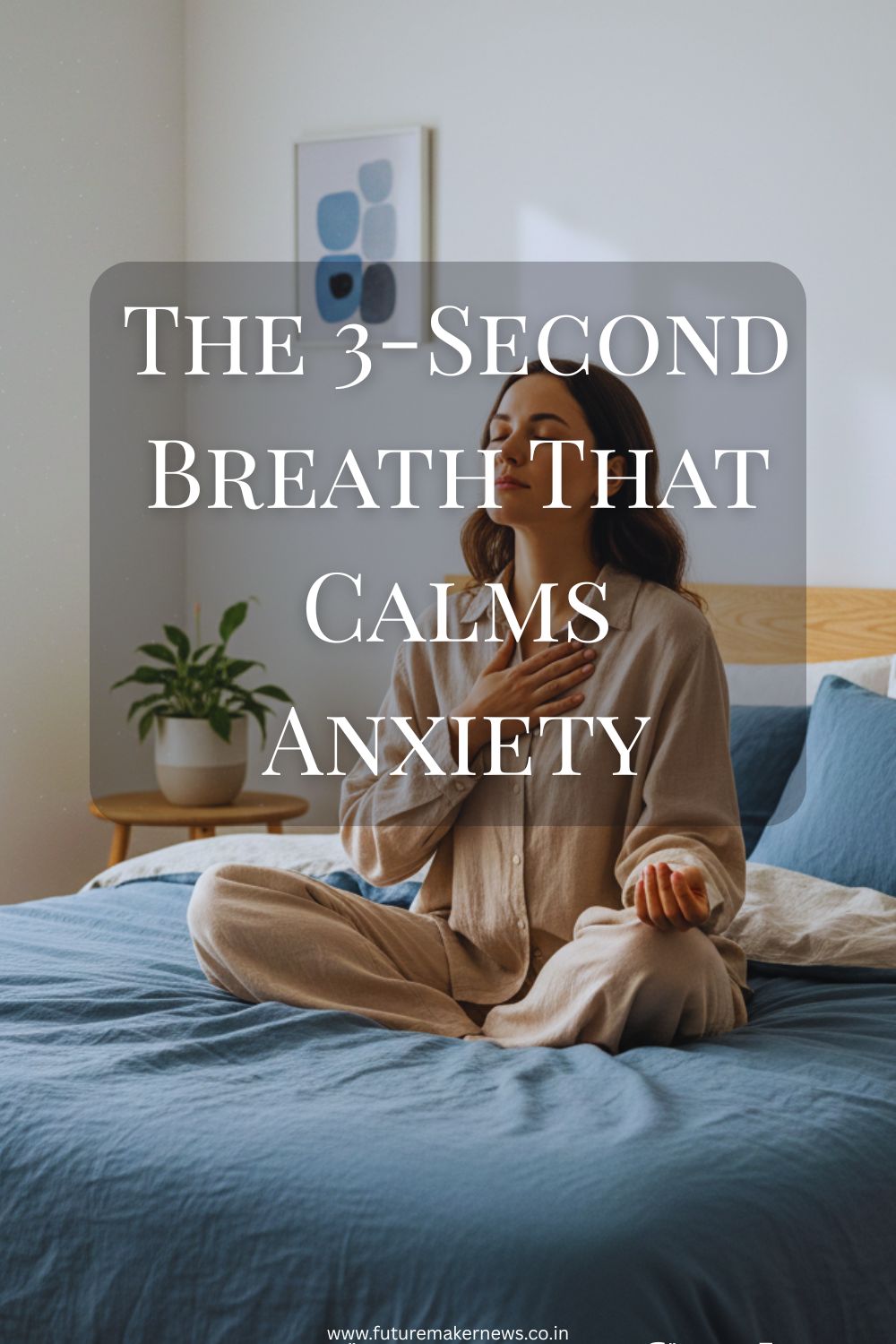Have you ever noticed how anxiety always arrives uninvited — tightening your chest, racing your thoughts, and making even simple tasks feel impossible? You’re not alone.
Millions of people struggle with anxiety daily. We try meditation, affirmations, or long breathing sessions — but sometimes, the real solution is shockingly simple.
Enter the 3-Second Breathing Technique for Anxiety — a quick, science-backed method that can calm your nervous system, quiet your thoughts, and ground you in the moment — all in just three seconds.
This isn’t another “just breathe” cliché. It’s a practical, proven way to stop anxiety fast and bring your mind back to peace.
Understanding Why Anxiety Feels So Overwhelming

Before diving into the technique, it helps to know why anxiety feels so overpowering.
Anxiety triggers your body’s fight-or-flight response — an ancient mechanism designed to protect you from danger. The problem? Modern life constantly activates that system — deadlines, social pressure, overthinking, and endless screens.
What Happens When Anxiety Strikes
- Breathing becomes shallow and rapid
- Heart rate increases, preparing for “action”
- Thoughts spiral out of control, making small issues feel huge
Here’s the secret: your breath is the remote control for your body. When you control your breath, you send a powerful signal to your brain — “I’m safe. You can relax now.”
And that’s where the 3-Second Breathing Technique comes in.three seconds to begin.
What Is the 3-Second Breathing Technique?
The 3-Second Breathing Technique is a short, mindful breathing pattern designed to relieve anxiety quickly.
Here’s the simple formula:
Inhale for 3 seconds → Hold for 3 seconds → Exhale for 3 seconds.
That’s it. Just nine seconds total — and your body starts switching from stress mode to calm mode.
When you’re anxious, complex breathing methods can feel overwhelming. But three seconds? That’s doable anytime — in your car, at work, or lying awake at night.
This short technique activates your parasympathetic nervous system, responsible for relaxation and balance. Within moments, your heartbeat slows, your thoughts clear, and your tension starts to melt away.tivates the parasympathetic nervous system — the part of your body responsible for rest and relaxation — helping your heart rate slow and your mind clear.
How the 3-Second Breathing Technique Works

Every breath you take sends messages between your body and brain. When you breathe slowly and intentionally, you rewire your stress response.
The Science Behind It
- Breaks the anxiety loop: Interrupts racing thoughts and resets focus.
- Balances oxygen levels: Shallow breathing disrupts oxygen flow — this restores it.
- Activates calm signals: Deep, rhythmic breathing tells your brain, “You’re safe.”
- Restores control: When everything feels chaotic, controlled breathing reminds you that you’re still in charge.
In just three seconds, your body begins to shift from tension to tranquility.
How to Practice the 3-Second Breathing Technique
You can do this technique anywhere, anytime — no equipment, no silence, no pressure.
Step-by-Step Guide
Step 1: Inhale for 3 Seconds
Breathe in slowly through your nose. Feel the air expand your lungs and chest. Focus on how the air feels — cool, calm, cleansing.
Count: 1… 2… 3…
Step 2: Hold for 3 Seconds
Pause. Don’t strain — just hold gently. This moment of stillness resets your nervous system.
Count: 1… 2… 3…
Step 3: Exhale for 3 Seconds
Breathe out slowly through your mouth. Release every ounce of tension and negative energy.
Count: 1… 2… 3…
Repeat this 5–10 times until you start to feel grounded and lighter.
When to Use the 3-Second Breathing Technique

This simple technique can be your emotional first-aid kit for any stressful situation.
Use it when:
- You feel panic or anxiety coming on
- You’re about to enter a meeting or tough conversation
- You’re lying in bed and can’t quiet your thoughts
- You’re overwhelmed during work or study
- You’re emotionally drained and need to reset
Because it takes only seconds, it’s perfect for on-the-go anxiety relief.
Grounding + Breathing = Double Calm
To make your practice even more effective, combine it with grounding techniques — simple ways to bring your mind back to the present.
Try This Combo:
While breathing, say softly in your mind:
- “I’m safe right now.”
- “This moment is enough.”
- “I’m breathing. I’m okay.”
Or engage your senses:
- Name 3 things you see
- Notice 2 sounds you hear
- Feel 1 physical sensation (your hands, feet, or heartbeat)
This strengthens your focus and anchors your mind in the now, breaking the anxiety cycle faster.th + grounding) helps your brain disconnect from panic and reconnect with reality.
Common Mistakes to Avoid

Even though this breathing technique is simple, a few missteps can reduce its impact.
Avoid These Mistakes:
- Breathing too fast — the point is calm, not control.
- Tight breath-holds — gentle pause, not strain.
- Expecting instant perfection — it’s a practice, not a test.
- Using it only in crisis — consistency builds resilience.
Make it a daily ritual, and your body will naturally remember the calm rhythm even in stressful moments.
What Happens When You Do It Right
After a few rounds, you’ll likely notice:
- Softer breathing and relaxed shoulders
- Slower heart rate
- Fewer racing thoughts
- A subtle sense of peace
These are physical signs your parasympathetic nervous system is active — your body’s natural calm mode is taking over.alance.
Turn It into a Daily Practice

Breathing isn’t just a reaction — it can become a ritual of renewal.
Simple Daily Uses:
- Morning Reset: Use it right after waking to start calm and clear-headed.
- Midday Pause: Practice between tasks to recharge focus.
- Night Wind-Down: Use before sleep to release tension.
Even 3–5 minutes a day can dramatically improve how your mind handles stress.eed hours of meditation — just a few mindful breaths can shift your entire emotional landscape.
Stop Searching, Start Breathing
It’s easy to fall into the trap of searching for relief instead of actually practicing it. We chase new apps, new methods, new “fixes,” forgetting that the simplest answer is already within us.
Your breath is the bridge between chaos and calm. The more you use it intentionally, the less power anxiety holds over you.
So the next time you feel overwhelmed, stop scrolling and start breathing:
Inhale 3… Hold 3… Exhale 3…
That’s all it takes to reclaim your peace — one breath at a time.
Final Thoughts: Calm Is Already Within You
You don’t have to wait for the perfect environment, playlist, or therapy session to find peace.
Peace begins with a single, mindful breath — your personal anchor in every storm.
Every inhale reminds you of life. Every exhale reminds you that it’s okay to let go.
So breathe deeply and remind yourself:
“In this breath, I am safe. In this moment, I am enough.”
The 3-Second Breathing Technique isn’t just a stress hack — it’s a daily reminder that relief doesn’t come from searching.
It comes from doing.

